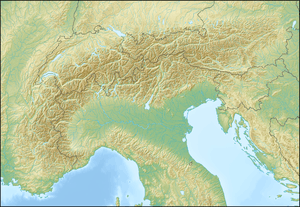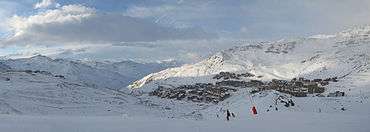Val Thorens
| Val Thorens | |
|---|---|
 Val Thorens from 3,200 m (10,500 ft) | |
 Val Thorens Location within Alps | |
| Location | Savoie, France |
| Nearest city | Chambéry |
| Coordinates | 45°17′53″N 6°34′48″E / 45.29806°N 6.58000°E |
| Top elevation | 3,220 m (10,560 ft) |
| Base elevation | 1,850 m (6,070 ft) |
| Runs |
|
| Lift system | 31 (Capacity 60,680ph) |
| Terrain parks | 4 |
| Website |
www |
Val Thorens, located in the Tarentaise Valley, Savoie, French Alps, is the highest ski resort in Europe,[1] at 2300 m altitude. It is located in the commune of Saint-Martin-de-Belleville in the Savoie département. The resort forms part of the 3 vallées linked ski area which, with over 600 km of piste, is the largest linked ski area in the world.
Resort
In the 1960s the potential of Val Thorens to be transformed from summer pasture into a location for a purpose built ski area was noted. Prior to this the development of Les Menuires at 1850m was begun in 1967. In 1969 the access road was extended up to Val Thorens so that development of the resort could start. In 1971 the first of 3 drag lifts was installed, followed in 1972 by the opening of the first ski school. Like many 1960s purpose built resorts in the French Alps, Val Thorens suffered from a lack of architectural guidelines in the early days, leading to an over-dependence on concrete. New and renovated developments now have to meet much stricter design guidelines and the use of traditional materials is sought.[2]
Access
The nearest airports are Chambéry, Lyon and Geneva. They have a transfer time of 2 hours, 2 hours 45 mins and 3 hrs 15 mins respectively. Alternatively the resort is nearly 1 hour from Moutiers for the snow train.[3]
Skiing
Given the high altitude of Val Thorens and the Glacier de Péclet the often large volume of snow means that the resort is usually open from mid-November until early May. The highest ski-able peaks are Pointe du Bouchet (3220 m) and Cime de Caron (3200 m), with its cable car of the same name, one of the biggest in the world with a capacity of 150+1 passengers.[4]

Many of the slopes in Val Thorens face north and north-west, providing for good snow conditions. This means that the slopes are not as sunny, so the resort tends to attract a crowd more interested in skiing than "terracing". However, the resort itself faces south, and many people enjoy sitting outside in the sunshine when they have finished skiing. Val Thorens has a total of 68 marked runs, and several terrain parks. The main snow park sees top level freestyle competitions every winter as it hosts a stage of the national SFR Slopestyle Tour, and the ski cross arena is frequently visited by the FIS Skier X World Cup. Jean-Fred Chapuis, who won the Skier X event at the 2014 Olympics in Sochi, hails from Val Thorens and the ski cross track is named after him.
Val Thorens is the most visited international ski resort in France: more than 70% of its visitors are foreigners. While one will find people from all over the world in Val Thorens, British, Scandinavian, Belgian, Dutch and German tourists make up the majority.
Val Thorens is part of the 3 vallées ski domain, which is connected by a common ski pass. Jean Beranger set up the first ski school in Val Thorens: The ESF, and the Club des sport and the Tourism Office in 1972. Beranger is a former coach of the French women's ski team. He is now deputy mayor and president of the tourist office, and one slope in Val Thorens is named after him.
Summer skiing
Beginning in 1973 Val Thorens operated ski lifts all year round on the Peclet glacier. At time of opening the glacier included 3 surface lifts named Croissant, Chavière and Pointe and a chairlift named 3300. The summer ski area was then expanded in 1983 with the construction of an extra surface lift named Lac Blanc and an extra chairlift named Glacier. However, the glacier only contained difficult and very difficult slopes, hence naturally limiting visitor numbers. Compounded by the melting glacier, lifts were slowly removed until the summer of 1989 when only the Glacier & 3300 chairlifts remained on the glacier - at this time the operators decided that these two remaining lifts would from then on only be open during the winter ski season. 3300 was dismantled in 2002 making the Glacier chairlift the only surviving lift used for summer skiing on the glacier.[5]
In 2012 a report was published as part of an april fools joke claiming that the resort would re-open for summer skiing.[6]
Lift System
Val Thorens has 31 lifts, which include magic carpets, draglifts, chairlifts, gondolas, funitels and a cable car. There are 4 funitels; the Bouquetin, Péclet, Grand Fond and Thorens. The funitel concept was developed in Val Thorens, by the lift company, SETAM. It is a gondola that hangs from twin cables, and its key feature is its wind resistance.[7] The Péclet Funitel was built in 1990 and was the first in Europe. In the summer of 2011, the latest funitel, the Funitel de Thorens, was built at a cost of €6.5 million.[8]
Notable persons
Tarentaise Valley Skiing
Within the Tarentaise Valley you find the biggest concentration of ski resorts in the world. The most well-known neighbour systems are Paradiski (Les Arcs, La Plagne) and Espace Killy (Val d'Isère and Tignes). A weekly lift ticket in Val Thorens/Les Trois Vallées provides the choice to ski one day in each of the other two systems mentioned. There were once plans to interlink all systems and resorts to create the largest ski area in the world. However that vision was ended with the creation of the Vanoise National Park.
Tour de France
The resort hosted a Tour de France stage finish in 1994. Nelson Rodriguez of Colombia won the stage, which had the second highest elevation for a stage finish in the history of the Tour de France.
See also
References
- ↑ Wilson, A: Ski Atlas of the World: the complete reference to the best resorts, page 45. New Holland Publishers, 2007.
- ↑ "Past to Present Val Thornes". Valthonet.com. 1963-07-06. Retrieved 2012-03-19.
- ↑ "Transfers". Crystalski.co.uk. Retrieved 2012-03-19.
- ↑ "Accommodation". Skiurlaub-infos.com. Retrieved 2012-03-19.
- ↑ http://www.remontees-mecaniques.net/bdd/reportage-3681.html
- ↑ http://www.valthonet.com/events/news/val-thorens-to-open-for-summer-skiing
- ↑ "Val Thorens history". Valthorensguide.co.uk. 1971-12-18. Retrieved 2012-03-19.
- ↑ "Val Thorens ski area". Valthorensguide.co.uk. Retrieved 2012-03-19.
External links
| Wikimedia Commons has media related to Val Thorens. |
- Official Val Thorens website
- Official site of Les 3 Vallees, lift & piste info, cams, weather, snow etc
- An independent English language guide to Val Thorens
- Discover Val Thorens ski area
- Vanoise National Park
Coordinates: 45°17′53″N 6°34′48″E / 45.29806°N 6.58000°E